Back to Don's Maps
 Back to the review of hominins
Back to the review of hominins
Lagar Velho - the Hybrid Child from Portugal
The Lagar Velho site is a rock-shelter in the Lapedo valley, a limestone canyon ca. 140 km north of Lisbon, in the District of Leiria, central Portugal. A 24 000-year-old early modern human child burial known as The Lapedo child was discovered here.In 1998, the discovery of an early Upper Paleolithic human burial in this site has provided evidence of early modern humans from southern Iberia. The remains, the largely complete skeleton of an approximately 4 year old child buried with pierced shells and red ochre, is dated to ca. 24 500 years B.P. The cranium, mandible, dentition, and postcrania appear to present a mosaic of European early modern human and Neanderthal features, although this interpretation is disputed. If the child was indeed a hybrid of anatomically modern humans and Homo neanderthalensis, there could be significant implications regarding the Neanderthal interaction with Cro-Magnons and the taxonomical classification of these (possibly sub-) species.
Text above: Wikipedia

Morphological mosaic found on this 24 500-year-old skeleton from Portugal indicates that Neanderthals and modern humans are members of the same species who interbred freely. The child - Lagar Velho 1 - is modern overall but bears some Neanderthal traits, such as short lower-limb bones and a backward-sloping mandible.
Photo: Scientific American April 2000
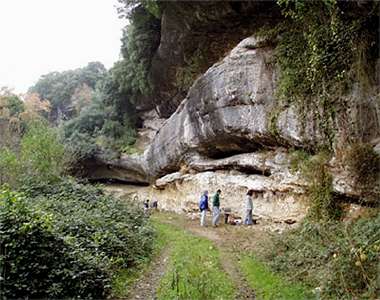
Lagar Velho before excavation
Photo: http://anthropology.net/2010/01/10/abrigo-do-lagar-velho-dental-study-neanderthal-hybrid-debate-continues/
Photo Credit: João Zilhão
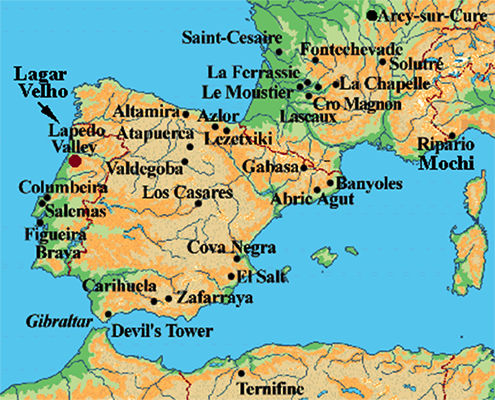
Map of Neanderthal sites in the Iberian Peninsula , SW France, and western Mediterranean region (Athena Review).
Photo: http://www.athenapub.com/8zilhao1.htm
Photo Credit: João Zilhão
The Fate of the Neanderthals
João Zilhão
The bones of a four-year-old child, buried for millennia in the rear of a rock-shelter in the Lapedo Valley 85 miles north of Lisbon, Portugal, comprised the first complete Palaeolithic skeleton ever dug in Iberia. Our November 28, 1998, find made national news, but an even greater surprise was in store when my colleague, Washington University anthropologist Erik Trinkaus, who measured the bones weeks after the discovery, reported that the child's anatomy could only have resulted from a mixed Neandertal-early modern human ancestry. Here, finally, was proof that Neandertals did not simply disappear from Europe 28 000 years ago. Instead, they interbred with modern humans and became part of our family.
The discovery was made by João Maurício and Pedro Souto, archaeology field assistants and members of a local archaeology group, who visited the valley at my request to check on reports that a student from a nearby village had found some prehistoric paintings. The reports turned out to be genuine. The student showed them a few small, red anthropomorphic figures in a style characteristic of the Copper Age (fourth and third millennia B.C.) painted on the back wall of a shallow rock-shelter on the north side of the valley.
While they were there, João and Pedro decided to inspect a larger shelter they saw on the opposite side of the valley. When they got there, the first thing they noticed was that archaeological deposits in the shelter had recently been destroyed; we later learned that in 1992 the landowner had bulldozed the upper six to nine feet of the shelter's fill to widen a rural trail used to reach property located farther up the valley. All that was left was a foot-and-a-half remnant of the original deposit in a fissure running along most of the length of the shelter's back wall. This remnant corresponds to a section of the original stratigraphic sequence lying between two and three feet below the former ground surface.
The remnant was extremely rich in charcoal, stone tools, and animal remains, including fossilized horse teeth, all suggesting an Upper Palaeolithic age (between 30 000 and 10 000 years ago) for the site. While collecting surface material that had fallen from the remnant, João and Pedro inspected a recess in the back wall. In the loose sediments they recovered several small bones stained with red ochre they thought could be human. Recognizing the potential significance of the discovery, they stopped investigating and reported their finds to me.
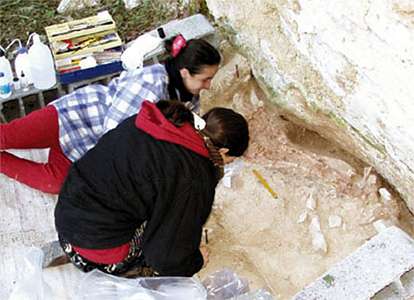
Archaeologists Cidália Duarte and Cristina Araújo excavated the child's skeleton.
Photo: http://www.archaeology.org/0007/abstracts/neandertals.html
Photo Credit: João Zilhão
The following weekend, on December 6, I went to the site with my colleagues Cristina Araújo, a fellow archaeologist, and Cidália Duarte, a bioarchaeologist specializing in burial taphonomy (how bodies are buried and preserved). João and Pedro presented their finds and two things almost immediately became clear. First, the bones they thought could be human were indeed the left forearm and hand bones of a young child. Second, stone tools found in the fissure dated the deposit to the Middle Solutrean and the Proto-Solutrean, that is, the period between 20 000 and 22 000 years ago. Since the juvenile human bones that lay some nine feet below this remnant belonged to a single individual and were very well preserved, the implication was obvious: a child had been buried at the site either in late Middle Palaeolithic or in early Upper Palaeolithic times, between 40 000 and 25 000 years ago. The ochre staining of the bones (a feature of all burials from the Gravettian period between 25 000 and 27 000 years ago) and rough estimates of the rate of sedimentation at the site led us to believe that a date closer to 25 000 years ago was more likely.
This conclusion prompted me to start a salvage excavation of the site, which we called the Lagar Velho rock-shelter after the ruin of an ancient olive-oil press at its entrance. The excavation began on December 12, 1998, continuing without interruption through Christmas and the New Year until January 7, 1999.
Throughout the 1998-1999 salvage work we were able to count on the invaluable advice of Erik Trinkaus, to whom I e-mailed digital pictures of the excavation daily. Realizing the potential significance of the burial, Cidália Duarte and I invited him to the site to study the skeleton. An authority on Neandertals and early modern humans, Erik was already involved in analyzing Palaeolithic human material from Portugal.
While Cidália and I completed the fieldwork, Erik began to clean and reassemble the skeleton and work toward a preliminary anatomical description. After returning to the United States, he was able to compare the bones with his extensive data base on Neandertals and early modern humans. On January 25, I got a message from him which began with the ominous words: 'The end of last week I made some quick comparisons of the Lagar Velho [child's] leg bone proportions with some data that I have, and it comes out looking like a Neandertal!' Other resemblances with Neandertals followed, but throughout this initial stage Cidália and I kept in mind Erik's cautionary remark in that first message: 'unless I have made some silly mistake.'
We decided to check and double check all the measurements ourselves, and eventually concluded that Erik had made no mistake - the child did present a mosaic of Neandertal and modern human features. Most prominent among the former, the arctic body proportions (with short limbs, especially the lower parts of the arms and legs), the robusticity of the limb bones and the angle at which the jaw bones meet at the chin; among the latter, the characteristic 'snow-plow' chin and the size of the dentition
The Lagar Velho Child and the Fate of the Neanderthals
João Zilhão, Instituto Português de Arqueologia

João Zilhão is the director of the Instituto Português de Arqueologia, Ministério da Cultura. Born in 1957, he received a Ph.D. in Prehistoric Archaeology from the University of Lisbon, where he taught between 1984 and 1995, with a dissertation on the Upper Palaeolithic of Portugal. In January 1996, he was appointed by the Portuguese government to set up the Côa Valley Archaeological Park, to coordinate the scientific research carried out to establish the chronology of the valley's Palaeolithic rock art, and to prepare the application of the site to the World Heritage List. In May 1997, he was appointed director-general of the newly created Instituto Português de Arqueologia (IPA), the department of the Ministry of Culture that supervises all archaeological activity in the country.
In 1998, he directed the salvage excavation of the Early Upper Paleolithic child burial of Lagar Velho (Portugal) and, in 2004-2005, the archaeological excavations at the Peştera cu Oase (Romania), site of Europe’s earliest modern humans. He was the Conference Organizer for the year 2000 Annual Meeting of the European Association of Archaeologists, held in Lisbon, and was a member of its Executive Board between 2003 and 2006. In 2003, he was the recipient of a Humboldt Foundation Research Award (host institution: University of Cologne) in recognition of "past achievements in teaching and research." In 2005, he was the recipient of the London Prehistoric Society’s Europa Prize, in recognition of his "significant and enduring contribution to the study of European prehistory."
Photo and text: Zilhão (2001) and supplementary text from http://www.bris.ac.uk/archanth/staff/zilhao/
Laga Velho is a rock-shelter in the Lapedo valley, a limestone canyon cut by the river Caranguejeira. The site is very close to the city of Leiria, about 140 km north of Lisbon in central Portugal.
It was discovered in November 1998, following reports that late prehistoric paintings had been identified in the region. Further survey work in the valley led to the identification of this particular site.
The upper 2 to 3 metres of its sedimentary fill had been almost entirely removed by the owner in 1992. All that was left of this upper fill was a hanging remnant preserved in a fissure running along the back wall of the shelter which contained an extraordinary density of remains clearly of Upper Palaeolithic age. The current ground surface corresponds to the truncation of the lower part of the original sequence of archaeological deposits. The richness of the remnant suggested that this was a major site and, consequently, a rescue operation ensued in December-January 1998 - 1999, followed by two summer field seasons, in July 1999 and in June - October 2000. As a result, it has been possible to establish that the site contains three major archaeological components.
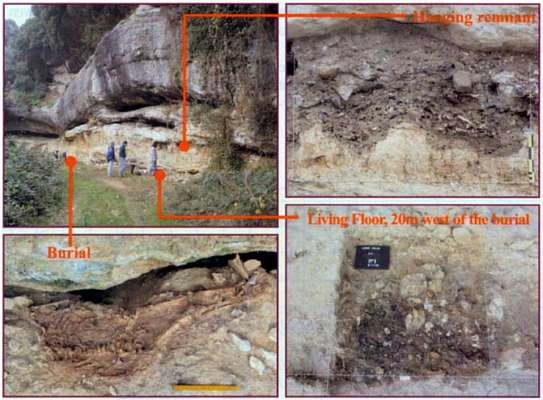
Lagar Velho: panoramic view along the rockshelter face with indication of the three major archaeological components: Burial; living floor; and hanging remnant.
Photo and text: Zilhão (2001)
Photo Credit: João Zilhão
The most recent deposits are those of the hanging remnant, which are particularly rich in the western part. Two main occupation levels were identified there. Level 6, charcoal stained and with abundant burnt cobbles, contains a faunal assemblage dominated by horse remains. The artefact assemblage is rich in quartz tools, contains some carinated cores, and features a couple of fine bone points, matching the characteristics of the Proto-Solutrean, a common occurrence in Portugal in stratigraphic sequences spanning the Last Glacial Maximum (LGM).
Three radiocarbon determinations on charcoal samples place this level between 22 000 and 21 000 BP. A marked discontinuity, which corresponds to an erosional hiatus, separates this unit from the overlying in situ deposits of Level 9, where charcoal is abundant, but not as much as in earlier deposits, and the amount of faunal remains also decreases somewhat. The lithics, however, are fully diagnostic of the Middle Solutrean, with thermally pre-treated laurel-leaf points. This level was dated from the charcoal to 20 000±180 years BP.
A settlement area with dense remains of occupation in the same western part of the site (squares G-I/3-4) and beginning about 1.5 metres below the base of the remnant, is preserved under ground level.
Throughout its Gravettian period occupation the western part of the shelter was used for ordinary settlement activities. The one burial episode so far documented took place in the easternmost part of the site, located far away from the settlement, and separated from the outer edge of the latter by more than 10 metres of archaeologically empty space.
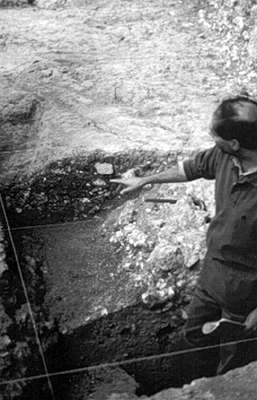
João Zilhão pointing out the Gravettian levels just along the rock face from the child burial.
Photo: http://www.ucl.ac.uk/prehistoric/past/past36.html
Photo Credit: William Davies, October 2000
The particular location selected took advantage of a small recess in the back wall of the shelter that, at the time of burial, created a protective overhang almost at ground level, forming a kind of natural niche ready-made to receive the body of the child that archaeologists eventually catalogued as fossil LV1. However, similar niches exist in the back wall of the shelter in the area where the living floors are located. It must be concluded, therefore, that there was an unequivocal intention to bury the child away from the areas that people used for the day to day living activities carried out in the framework of the site's use as a residential or logistical place.
The LV1 child burial
The area where the burial took place was tested down to about two metres below the present ground surface. The deposits contained faunal elements but were otherwise archaeologically sterile. The faunal assemblage contained abundant coprolites and bones (horse, deer and rabbit) showing evidence of gnawing by carnivores. It is quite likely that this part of the shelter functioned as a wolf den until the time period represented by the burial event. Pollen analysis of the sequence excavated in square L20, under the burial, produced a diagram dominated by pine and heather. More work needs to be done before the site's surrounding palaeovegetation can be securely reconstructed.
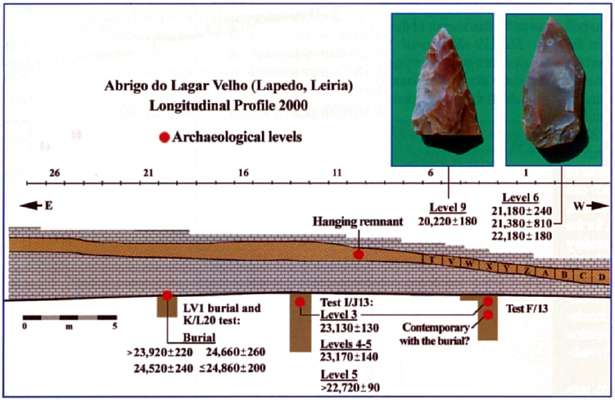
Longitudinal section drawing of the hanging remnant at Lagar Velho, showing inset photos of a Proto-Solutrean Vale Comprido point derived from level 6, and a Solutrean laurel-leaf point from level 9.
Photo and text: Zilhão (2001)
Photo Credit: João Zilhão

Point of the Vale Comprido Point type discovered in 2008 at Marseillon, near the town of Banos, France. Note the development of the lateral edges and the thinning of the base by a flat inverse retouch, giving this specimen the edges and flat surfaces of the early Solutrean.
The site of Marseillon, Banos (Landes) is an open-air site located on the bank of the Gabas and its confluence with the stream of Laudon. The site was discovered accidentally by P. Laffitte, surveyor and amateur archaeologist. The acidity of the sediments does not allow the preservation of organic materials and only the lithic remains are preserved.
Identifiant de l'illustration : I2008-AQ-0066-01
Photo: Renard, Caroline (DOC); Teyssandier, Nicolas (DOC)
Type: dessin de mobilier
Sujets: industrie lithique; pointe.
Région: Aquitaine, Département: Landes, Commune: Banos
Photo and text: http://www.adlfi.fr/SiteAdfi/document?base=base_illus&id=I2008-AQ-0066-01
http://traces.univ-tlse2.fr/69169131/0/fiche___pagelibre/&RH=Societes_traces
The burial of the Lagar Velho LV1 child lay only a few centimetres below current ground surface. It was the slight overhang of the shelter's back wall that saved it from total destruction when the site was terraced. The skull was missing, because it originally lay slightly higher than the rest of the body and was shattered by the bulldozer. Fortunately, it was possible to recover most of its fragments, which were scattered in the thin level of disturbed deposits that covered the burial and surrounding areas. For the most part they were found in a dense accumulation located some three metres eastwards of the burial along the back wall of the shelter.
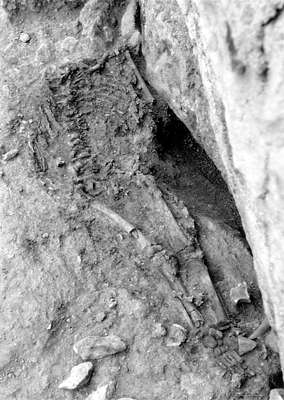
Lagar Velho 1 in situ, with damaged skull and left forearm elements already removed.
Careful excavation and screening of all these disturbed deposits allowed the recovery of some 160 fragments and, subsequently, the reconstruction of about 80% of the total skull. The post-cranial skeleton was virtually complete as well as the child's permanent and deciduous dentitions.
The reconstructed burial ritual is very similar to that documented in contemporaneous funerary contexts of Central and Eastern Europe, showing that, culturally, these populations were fully integrated into the Gravettian world. The body was laid down in extended position, slightly tilted towards the back of the shelter, left foot on top of the right one.
Photo and text: Duarte et al. (1999)
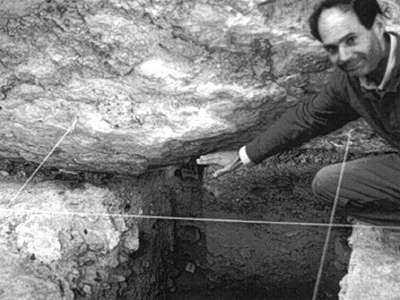
João Zilhão showing the position of the child's head.
Photo: http://www.ucl.ac.uk/prehistoric/past/past36.html
Photo Credit: William Davies, October 2000
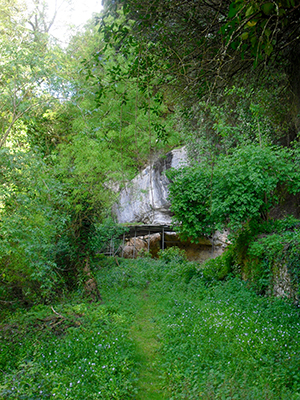
Lagar Velho excavation site.
Photo: Nunorojordao
Permission: The photographer has graciously released this into the Public domain
Prior to the deposition of the body, a small fire had been lit in the shallow pit excavated for the grave. Analysis of the charcoal recovered from under the child's right leg shows that the burned wood was a single branch of Scots Pine, Pinus sylvestris. The C14 date of ca. 24 000 obtained from this charcoal is, therefore, the closest estimation for the age of the burial event. An absolute upper limit for such and age is provided by the date of ca. 23 000 BP obtained from a bone sample collected from a semi-articulated ensemble of rabbit ribs and vertebrae directly overlying the child's right leg.
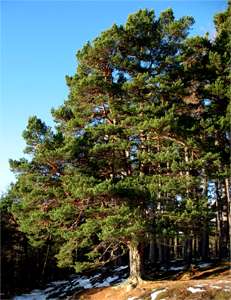

Scots Pine tree and cones.
Left Photo: The Scots Pine (Pinus sylvestris) Pinus sylvestris, Spittal of Glenmuick, Cairngorm National Park, Scotland, 56°58'22"N 3°8'15"W, 400m altitude.
Date 2008-01-06 Source: Bruce on Flickr
Permission: This file is licensed under the Creative Commons Attribution-Share Alike 2.0 Generic license.
Right Photo: The Scots Pine - cones (Pinus sylvestris), near Boronów, Poland
Date: 06.07.2008 Source: Pleple2000
Permission: This file is licensed under the Creative Commons Attribution-Share Alike 3.0 Unported, 2.5 Generic, 2.0 Generic and 1.0 Generic license.
The red staining of the burial context is related to the use of ochre in the burial ritual. Since both upper and lower surfaces of the bones were stained, we infer that the body must have been wrapped in a shroud of ochre-painted skin, whose subsequent decay caused the transfer of the pigment to the skeleton and surrounding pigment. The presence of a semi-rigid durable wrap around the body would also have provided the empty space necessary for the normal post-mortem plantar flexion or downward pointing of the child's feet.

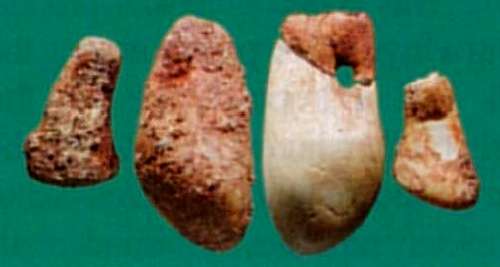
Artefacts and animal bones were found in close association with the skeleton. A Littorina obtusata shell pendant (left) was recovered at the child's neck. Four pierced red deer canines (right) were found in the cluster of displaced, small, red-stained fragments of the child's skull. The association of these deer canines with the cranial vault, as in contemporaneous burial from Italy and Moravia, suggests that they must have been part of a head-dress.
Photo and text: Zilhão (2001)
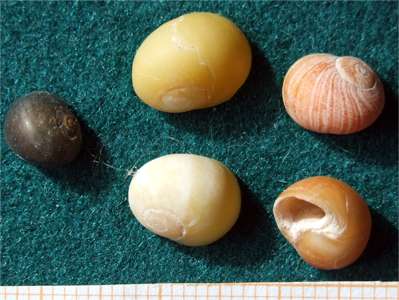
Flat periwinkle, Littorina obtusata, Sylt, Germany
Date: 2008-9-09
Source: G.-U. Tolkiehn
Permission: lisensen Creative Commons Navngivelse-Del på samme vilkår 3.0 Unported
The rabbit bones found between the child's legs - three vertebrae, four ribs and one sacral fragment - had a reddish colour identical to the human bones. The simplest explanation for this association is that part of the carcass of a rabbit was deposited in the grave, perhaps as a food offering.
Analysis of the red deer bones found at the head and feet of the child's skeleton, two left pelvises, one distal tibia and two tarsal bones were well preserved, and showed no evidence of carnivore activity in contrast to other similar bones found nearby, were in contact with the body, and showed C14 dates which were contemporaneous with the burial event. They may have been food offerings.
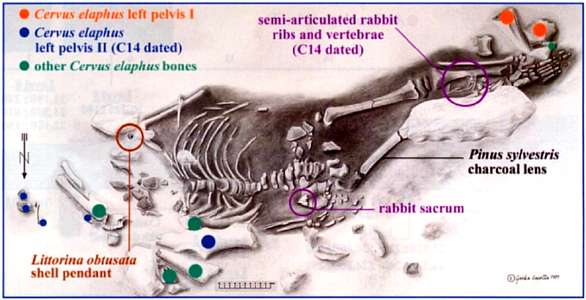
Plan of the Lagar Velho 1 skeleton after exposure was complete, showing artefacts and ecofacts associated with the boy's burial.
The age at death is estimated to lie between 3.5 and 5.0 years, and there are no indications of pathological conditions that might have affected normal skeletal development. During the excavation it was assumed that the skeleton represented that of a Gravettian early modern human child belonging to a population no different from those well documented by contemporaneous finds elsewhere. This view was based on the clear presence of a very prominent chin.
Photo and text: Zilhão (2001)
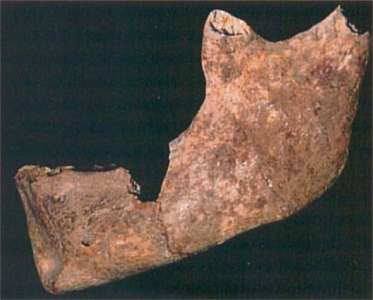
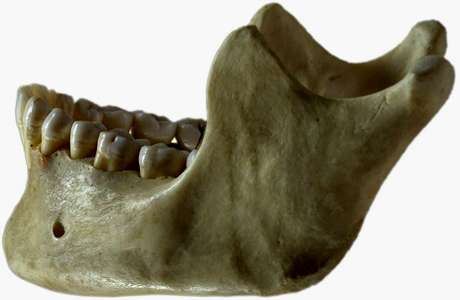
(left) Lagar Velho 1: left mandible, lateral view, showing prominent chin, but a retreating symphyseal profile, which is characteristic in immature Neanderthals. (That is, the chin is retreating compared with modern humans - Don)
Photo: Zilhão (2001)
Photo Credit: Erik Trinkaus
(right) modern human jaw for comparison, showing the protruding symphyseal profile, that is, a protruding chin.
Photo: Gregory F. Maxwell
Date: 2006-05-07
Permission: GNU Free Documentation License
Further analysis showed that the skeleton also possessed a suite of other traits that aligned it with the known sample of other early modern humans from Europe and the Near East. For instance, Neanderthals exhibit relatively larger anterior mandibular teeth than early modern humans. In this regard, the Lagar Velho child falls in the middle of the early modern human distribution. In addition, Neanderthals and early modern humans contrast in the relative proportions of their thumb phalanges. The Lagar Velho child closely approaches the proportions seen among early modern humans, and is distinct from the Neanderthal pattern.
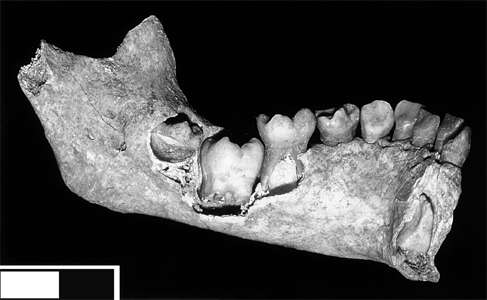
Lingual view of the mandible and dentition of the Lagar Velho child, showing the degrees of dental development, the symphyseal retreat, and the prominent right tuberculum laterale. (Black bar and white bar = 1 cm each.)
(Symphisis: A growing together of bones originally separate, as for the two halves of the lower jawbone. In this case the symphyseal retreat refers to the receding chin typical of Neanderthals.
Tuberculum laterale - lateral swelling. - Don)
Photo and text: Duarte et al. (1999)
Other features of the child's anatomy, however, suggest clear Neanderthal affinities. Of paramount importance in this regard are the relatively short lower limb segments, reflected in the proportions of its tibial length to femoral length. This ecographical proportion, indicating a hyperarctic pattern among the Neanderthals and a tropical one for early modern humans, completely separates the Neanderthals from these early modern human groups. The Neanderthals have proportionately shorter tibiae relative to their femora.

Anterior view of the long bones. (Black and white bars = 1 cm each.)
Photo and text: Duarte et al. (1999)
A second feature indicating Neanderthal affinities is the retreat of the mandibular symphysis, despite the presence of a prominent bony chin.
(bold mine in the text below - Don)
This morphological mosaic forms the basis for the interpretation that LV1 is a modern human child with genetically inherited Neanderthal traits. This indicates that the population to which it belonged was the evolutionary product of a process of admixture between Neanderthals and early modern humans occurring several millennia before, at the time the latter first dispersed into Iberia, 28 000 to 30 000 years ago.
This unique combination of derived modern human traits with genetically inherited Neanderthal traits suggests that the last Neanderthal groups living in Iberia ca 28 000 years ago contributed to the gene pool of subsequent early Upper Palaeolithic populations of the peninsula.
However, as in the rest of Europe, no demonstrably Neanderthal-modern mixed cultures exist in the Iberian peninsula.
The Hybrid Child from Portugal
by Erik Trinkaus and Cidalia Duarte
From Who were the Neanderthals? Scientific American April 2000On a chilly afternoon in late November 1998, while inspecting the Abrigo do Lagar Velho rock-shelter in central Portugal's Lapedo Valley, two archaeology scouts spotted loose sediment in a rodent hole along the shelter's back wall. Knowing that burrowing animals often bring deeper materials to the surface, one of the scouts reached in to see what might have been unearthed. When he withdrew his hand, he held in it something extraordinary: bones of a human child buried nearly 25,000 years ago.
Subsequent excavation of the burial, led by one of us (Duarte), revealed that the four-year-old had been ceremonially interred-covered with red ochre and laid on a bed of burnt vegetation, along with pierced deer teeth and a marine shell-in the Gravettian style known from modern humans of that time across Europe.Based on the abrupt cultural transition seen in archaeological remains from the Iberian Peninsula,it seemed likely that when moderns moved into the area after 30,000 years ago,they rapidly replaced the native Neandertals.So it stood to reason that this specimen, called Lagar Velho 1, represented an early modern child. In fact, it didn't occur to us at first that it could be anything else.
This wonderfully complete skeleton does have a suite of features that align it predominantly with early modern Europeans. These include a prominent chin and certain other details of the mandible (lower jaw), small front teeth, characteristic proportions and muscle markings on the thumb, the narrowness of the front of the pelvis, and several aspects of the shoulder blade and forearm bones.Yet intriguingly, a number of features also suggest Neandertal affinities-specifically the front of the mandible (which slopes backward despite the chin), details of the incisor teeth, the pectoral muscle markings, the knee proportions and the short, strong lower-leg bones.Thus,the Lagar Velho child appears to exhibit a complex mosaic of Neandertal and early modern human features.
This anatomical amalgam is not the result of any abnormalities.Taking normal human growth patterns into consideration, our analysis indicates that except for a bruised forearm, a couple of lines on the bones indicating times when growth was trivially arrested (by sickness or lack of food) and the fact that it died as a child, Lagar Velho I developed normally.The combination can only have resulted from a mixed ancestry-something that had not been previously documented for western Europe.We therefore conclude that Lagar Velho 1 resulted from interbreeding between indigenous Iberian Neandertals and early modern humans dispersing throughout Iberia sometime after 30,000 years ago. Because the child lived several millennia after Neandertals are thought to have disappeared, its anatomy probably reflects a true mixing of these populations during the period when they coexisted and not a rare chance mating between a Neandertal and an early modern human.
Fieldwork conducted last summer yielded major portions of the skull and most of the remaining teeth, along with more archaeological material. And in an effort to fully understand this remarkable specimen,we have organized a team of specialists to examine the skeleton further. Among the projects planned are CT scan analyses of the skull and limb bones and computer based virtual reconstruction of the damaged skull. Rigorous study is necessary because the discovery of an individual with such a mosaic of features has profound implications. First, it rejects the extreme Out of Africa model of modern human emergence, which proposes that early moderns originating in Africa subsequently displaced all archaic humans in other regions. Instead the Lagar Velho child's anatomy supports a scenario that combines a dispersal of anatomically modern humans out of Africa with mixing between that population and the archaic populations it encountered. (The African ancestry of early modern Europeans is reflected in their relatively long lower-leg bones, a tropical adaptation. Lagar Velho 1, however, has the short shins of the cold-adapted Neandertals.)
Lagar Velho 1 also provides insights into the behavioral similarities of Neandertals and early modern humans. Despite the paleontological evidence indicating anatomical differences between these two groups, their overall adaptive patterns, social behaviours and means of communication (including language) cannot have contrasted greatly. To their contemporaries, the Neandertals were just another group of Pleistocene hunter-gatherers, fully as human as themselves.
ERIK TRINKAUS is a paleoanthropologist at Washington University.
CIDALIA DUARTE is completing her Ph.D. in physical anthropology at the University of Alberta in Canada and is the human osteologist at the Portuguese Institute of Archaeology in Lisbon.
From:
http://www.artsci.wustl.edu/~anthro/lv.html
In addition to providing evidence of a 25,000 year old ritual burial (with burnt pine branches, red ochre, pierced teeth and shell) of a 4 year old Paleolithic child, the analysis has revealed that the child exhibits distinctive characteristics of both contemporaneous European early modern humans and preceding Neandertals. It therefore provides evidence of previous admixture between Neandertals and early modern humans in southwestern Europe. As a result, it has become a focus of ongoing research by Prof. Trinkaus and others concerning the evolutionary dynamics of the emergence of modern humans across the Old World.
From the N.Y. Times April 25, 1999
Discovery Suggests Humans Are a Bit Neanderthal
By John Noble Wilford
Neanderthals and modern humans not only coexisted for thousands of years long ago, as anthropologists have established, but now their little secret is out: they also cohabited.
At least that is the interpretation being made by paleontologists who have examined the 24,500-year-old skeleton of a young boy discovered recently in a shallow grave in Portugal. Bred in the boy's bones seemed to be a genetic heritage part Neanderthal, part early modern Homo sapiens. He was a hybrid, they concluded, and the first strong physical evidence of interbreeding between the groups in Europe.
"This skeleton demonstrates that early modern humans and Neanderthals are not all that different," said Dr. Erik Trinkaus, a paleoanthropologist at Washington University in St. Louis. "They intermixed, interbred and produced offspring."
Although some scientists disputed the interpretation, other scientists who study human origins said in interviews last week that the findings were intriguing, probably correct and certain to provoke debate and challenges to conventional thinking about the place of Neanderthals in human evolution.
Neanderthals and modern humans presumably were more alike than different, not a separate species or even subspecies, but two groups who viewed each other as appropriate mates.
Recent DNA research had appeared to show that the two people were unrelated and had not interbred. Neanderthals lived in Europe and western Asia from 300,000 years ago until the last of them disappeared on the Iberian peninsula about 28,000 years ago. In the prevailing theory today, modern humans arose in Africa less than 200,000 years ago and appeared in great numbers in Europe, starting about 40,000 years ago.
The new discovery could, at long last, resolve the question of what happened to the Neanderthals, the stereotypical stocky, heavy-browed "cave men." They may have merged with modern humans, called Cro-Magnons, who appear to have arrived in Europe with a superior tool culture. In that case, some Neanderthal genes survive in most Europeans and people of European descent.
The skeleton of the boy, buried with strings of marine shells and painted with red ocher, was uncovered in December by Portuguese archeologists led by Dr. Joo Zilhao, director of the Institute of Archeology in Lisbon. The discovery was made in the Lapedo Valley near Leiria, 90 miles north of Lisbon.
Realizing the potential significance, Dr. Zilhao called in Dr. Trinkaus, an authority on Neanderthal paleontology, who went to Lisbon and examined the bones in January.
The boy, who was about 4 years old at death, had the prominent chin and other facial characteristics of a fully modern human. But his stocky body and short legs were those of a Neanderthal. Dr. Trinkaus compared the limb proportions with Neanderthal skeletons, including some children. He said he was then sure of the skeleton's implications.
"It's a complex mosaic, which is what you get when you have a hybrid," Dr. Trinkaus said. "This is the first definite evidence of admixture between Neanderthals and European early modern humans."
The age of the skeleton, determined by radiocarbon dating, showed that full Neanderthals had apparently been extinct for at least 4,000 years before the boy was born. "This is no love child," Dr. Trinkaus said, meaning that this was not evidence of a rare mating but a descendant of generations of Neanderthal-Cro-Magnon hybrids.
Dr. Trinkaus and Dr. Zilhao have completed a more detailed scientific report to be published soon in the Proceedings of the National Academy of Sciences. DNA tests on the skeleton have not yet been done.
Other Neanderthal specialists reacted favorably to the discovery. Dr. Fred H. Smith of Northern Illinois University in De Kalb called it "very convincing and absolutely right."
Dr. Smith noted that he had come upon other skeletal material in central Europe that raised the possibility of interbreeding between the groups. Though most scholars in the field will probably accept the possibility of interbreeding, he said, a significant number will probably not.
The more ardent exponents of the out-of-Africa hypothesis of modern human origins may be holdouts. They have argued that early modern humans all emerged from Africa and wiped out the Neanderthal population in Europe. Whether the relationship was fraternal or genocidal has been much debated. But many have argued that the two groups were distinct, with humans displacing and probably slaughtering their rivals.
Dr. Chris Stringer, an expert on Neanderthals at the Museum of Natural History in London, who is a leader of the out-of-Africa forces, said that he was willing to consider the Portuguese findings with an open mind. He told The Associated Press that the current evidence was not sufficient to convince him of Dr. Trinkhaus's hybrid interpretation.
An alternative theory, known as regional continuity, holds that the earliest human ancestors arose in Africa and spread around the world more than a million years ago. Modern humans then emerged in different regions through separate evolution and interbreeding. A leading advocate of this theory is Dr. Milford Wolpoff, a paleontologist at the University of Michigan in Ann Arbor.
"This find should be devastating to the out-of-Africa people," Dr. Wolpoff said. "It shows their theory doesn't work, at least in Europe. And it shows that fundamentally, Neanderthals are the same species we are and they contributed their genes to European ancestry."
By now, scientists said, only a small fraction of Neanderthal genes have survived, the European gene pool having been further mixed through migrations during the spread of agriculture and invasions from the east.
But Dr. Wolpoff cautioned that it would take more than one skeleton to tell the effects of interbreeding apart from ordinary evolutionary changes, the result of genes modifying in response to environmental stresses.
Dr. Alan Mann, a specialist in human evolution at the University of Pennsylvania, called the Portuguese hybrid skeleton "some of the most important data we ever got about Neanderthals in human evolution," but said he was not sure that interbreeding had been established.
Dr. Trinkaus said the discovery "refutes strict replacement models of modern human origins" and also seemed to undermine interpretations of recent DNA research. Two years ago, Dr. Svante Paabo of the University of Munich in Germany, reported that a study of the genetic material DNA from Neanderthal remains and living humans indicated that Neanderthals did not interbreed with the modern humans.
At the time, scientists said the DNA results reinforced the idea that Neanderthals were a separate species from modern humans. If the new findings are correct, though, the two groups were probably more like different races of the same species.
"The problem with the DNA research was the interpretation," Dr. Trinkaus said. "It's demonstrably wrong. All that they showed is that Neanderthal biology is outside the range of living humans, not modern Homo sapiens back then."
Dr. Alan Templeton, an evolutionary geneticist at Washington University, said that some hybridization occurs without the effects showing up, for example, in mitochondrial DNA, which is passed only through the mother. "But if you look deep enough in evolutionary time, you find a lot of interbreeding," Dr. Templeton said. "That is what humanity is all about: we interbreed a lot."
References
- Duarte, C., Maurício, J., Pettit P., Souto P., Trinkaus E., Plicht van der H., Zilhão J., 1999: The early Upper Paleolithic human skeleton from the Abrigo do Lagar Velho (Portugal) and modern human emergence in Iberia, Proc Natl Acad Sci USA, 1999 Jun 22;96(13):7604-9.
- Zilhão J., 2001: The Lagar Velho Child and the Fate of the Neanderthals, Athena Review, Vol.2, no.4 (pp.33-39)